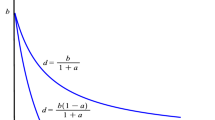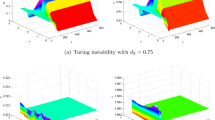Abstract
The study of spatial pattern formation through diffusion-driven instability of reaction–diffusion models of interacting species has long been one of the fundamental problems in mathematical ecology. The present article is concerned with interacting predator–prey reaction–diffusion model with Beddington–DeAngelis type functional response. The essential conditions for Hopf and Turing bifurcations are derived on the spatial domain. The parameter space for Turing spatial structure is established. Based on the bifurcation analysis, the spatial pattern formation in Turing space through numerical simulations is carried out in order to study the evolution procedure of the proposed model system in the vicinity of coexistence equilibrium point. The consequences of the results obtained reveal that the effects of self- and cross-diffusion play significant role on the steady state spatiotemporal pattern formation of the reaction–diffusion predator–prey model system which concerns the influence of intra-species competition among predators. Finally, ecological implications of the present results obtained are discussed at length towards the end in order to validate the applicability of the model under consideration.










Similar content being viewed by others
References
May RM (2001) Stability and complexity in model ecosystems. Princeton University Press, Princeton
Murray JD (1993) Mathematical biology. Springer, Berlin
Okubo A (1980) Diffusion and ecological problems: mathematical models. Springer, Berlin
Okubo A, Levin SA (2001) Diffusion and ecological problems: modern perspective. Springer, New York
Dubey B, Das B, Hussain J (2001) A predator–prey interaction model with self and cross-diffusion. Ecol Model 141:67–76
Kerner EH (1959) Further considerations on the statistical mechanics of biological associations. Bull Math Biophys 21:217–255
Shigesada N, Kawasaki K, Teramoto E (1979) Spatial segregation of interacting species. J Theor Biol 79:83–99
Turing AM (1952) The chemical basis of morphogenesis. Philos Trans R Soc Lond Ser B Biol Sci 237:37–72
Segel LA, Jackson JL (1972) Dissipative structure: an explanation and an ecological example. J Theor Biol 37:545–559
Gierer A, Meinhardt H (1972) A theory of biological pattern formation. Kybernetik 12:30–39
Levin SA, Segel LA (1976) Hypothesis for origin of planktonic patchiness. Nat Publ Group 259:659
Klausmeier CA (1999) Regular and irregular patterns in semiarid vegetation. Science 284:1826–1828
Beddington JR (1975) Mutual interference between parasites or predators and its effect on searching efficiency. J Anim Ecol 44:331–340
DeAngelis DL, Goldstein RA, O’neill RV (1975) A model for tropic interaction. Ecology 56:881–892
Cosner C, DeAngelis DL, Ault JS, Olson DB (1999) Effects of spatial grouping on the functional response of predators. Theor Popul Biol 56:65–75
Huisman G, De Boer RJ (1997) A formal derivation of the “Beddington” functional response. J Theor Biol 185:389–400
Du P, Duan C, Liao X (2014) Dynamics behaviors of a reaction–diffusion predator–prey system with Beddington–DeAngelis functional response and delay. Appl Math 5:843–851
Haque M (2011) A detailed study of the Beddington–DeAngelis predator–prey model. Math Biosci 234:1–16
He X, Zheng S (2015) Protection zone in a diffusive predator–prey model with Beddington–DeAngelis functional response. arXiv preprint arXiv:1505.06625
Li H, Takeuchi Y (2011) Dynamics of the density dependent predator–prey system with Beddington–DeAngelis functional response. J Math Anal Appl 374:644–654
Sarwardi S, Haque M, Mandal PK (2014) Persistence and global stability of Bazykin predator–prey model with Beddington–DeAngelis response function. Commun Nonlinear Sci Numer Simul 19:189–209
Wang R, Jia Y (2016) Analysis on bifurcation for a predator–prey model with Beddington–DeAngelis functional response and non-selective harvesting. Acta Appl Math 143:15–27
Zhang XC, Sun GQ, Jin Z (2012) Spatial dynamics in a predator–prey model with Beddington–DeAngelis functional response. Phys Rev E 85:021924(1–14)
Hassell MP, Varley GC (1969) New inductive population model for insect parasites and its bearing on biological control. Nature 223:1133–1137
Crowley PH, Martin EK (1989) Functional responses and interference within and between year classes of a dragonfly population. J North Am Benthol Soc 8:211–221
Skalski GT, Gilliam JF (2001) Functional responses with predator interference: viable alternatives to the Holling type II model. Ecology 82:3083–3092
Bazykin AD, Khibnik AI, Krauskopf B (1998) Nonlinear dynamics of interacting populations. World Scientific, Singapore, p 11
Guin LN (2015) Spatial patterns through Turing instability in a reaction–diffusion predator–prey model. Math Comput Simul 109:174–185
Guin LN, Mandal PK (2014) Spatial pattern in a diffusive predator–prey model with sigmoid ratio-dependent functional response. Int J Biomath 7:1450047(1–26)
Guin LN, Mandal PK (2014b) Spatiotemporal dynamics of reaction-diffusion models of interacting populations. Appl Math Model 38:4417–4427
Haque M (2009) Ratio-dependent predator–prey models of interacting populations. Bull Math Biol 71:430–452
Haque M (2012) Existence of complex patterns in the Beddington–DeAngelis predator–prey model. Math Biosci 239:179–190
Acknowledgements
The final form of the paper owes much to the helpful suggestions of the anonymous referees, whose careful scrutiny we are pleased to acknowledge. The authors also gratefully acknowledge the financial support in part from Special Assistance Programme (SAP-III) sponsored by the University Grants Commission (UGC), New Delhi, India (Grant No. F.510/3/DRS-III/2015(SAP-I)).
Author information
Authors and Affiliations
Corresponding author
Rights and permissions
About this article
Cite this article
Guin, L.N., Mondal, B. & Chakravarty, S. Stationary patterns induced by self- and cross-diffusion in a Beddington–DeAngelis predator–prey model. Int. J. Dynam. Control 5, 1051–1062 (2017). https://doi.org/10.1007/s40435-016-0281-7
Received:
Revised:
Accepted:
Published:
Issue Date:
DOI: https://doi.org/10.1007/s40435-016-0281-7
Keywords
- Beddington–DeAngelis predator–prey model
- Pursuit and evasion
- Self- and cross-diffusion
- Turing bifurcation
- Spatiotemporal pattern formation




